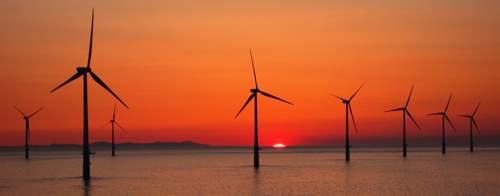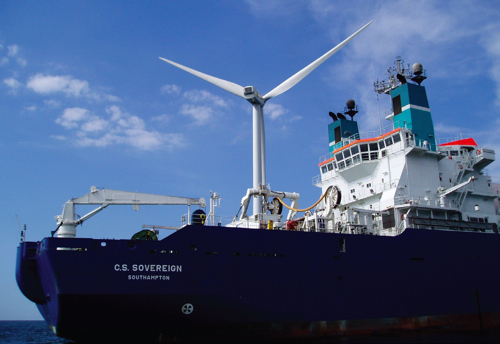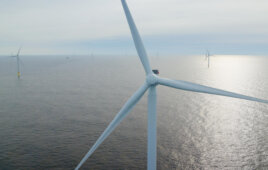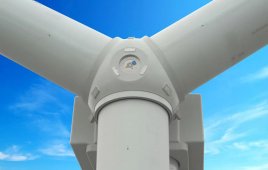
Generally, a large wind farm like this one will be up to 20 mi off shore. Work on it will proceed 24/7 with up to 40 vessels at a time, and each crewed by up to 60 men
Constructing offshore wind farms differs considerably from onshore work in that it introduces new hazards and opportunities. For a better view of what’s in store for offshore work, we spoke with Joel Whitman, CEO of Global Marine Energy Inc. His company specializes in offshore cable installations. Aside from an opportunity for steadier wind, offshore work has potential for job growth.
“Take a Cape Wind-sized project, for example,” says Whitman. “Its total cost is about $2 billion with the cable install work about 7% of that. Double that figure for supplies as well. So about 15% of all things are cable related,” he says.
Because the U.S. wind industry is grappling with cable installation as a major portion of offshore installations, the Jones Act enters many discussions. The 1920 Merchant Marine Act calls for all goods transported on water between U.S. ports carried in U.S.-flag ships, constructed in the U.S., owned by U.S. citizens, and crewed by U.S. citizens and permanent residents.
Whitman says the company’s goal in North America is to educate developers, investors, and anyone interested in the market. That will let his company put Europe’s lessons to use here.
Offshore wind needs two sets of cables. Consider an average offshore wind farm of about 300 MW and 150 turbines, suggests Whitman. “The first cables laid are for the interarray. These 6 to 7-in. dia., 33-kV cables connect the turbines. On average, turbines are 0.5 to 0.75-mi apart depending on terrain, but every turbine has at least one cable and those must be networked. Also, farms cover about 25 mi2, an area with variations in the sea bed,” he says. So before an install, it’s important to have a clear picture of the underwater terrain, soil, tides, and currents because a crew will have to pull the cable up to a turbine foundation, bury it between the turbines, pull it up to the next one, and so on.
“Laying 150 cables is a major logistics exercise,” he says. Arrays are then tied together with inter-array cable and usually to a substation on its own platform. That substation has an export cable, about 10-in. dia. that brings power to the shore grid.

Ships of this sort service the cabling operations for Global Marine Energy in the North Sea. In U.S. waters, Whitman says barges will be used first.
The work also involves specialized vessels and a weather window open from April to November, so work goes on 24 hours a day. Whitman says the North Sea uses ocean-going vessels because the industry has matured in that way, but North America will use barges resulting in a smaller weather window. One count in the North Sea at the peak of the season tallied up to 40 vessels on site at any time. “This will be a major work site, one with its own safety and health considerations,” he says.
An important issue driving all this work is need for American workers and vessels, all special marine equipment. “The crew for one vessel requires about 60 men, all of whom – from captain down to the deck hands – have to be certified for this type of work,” says Whitman. What’s more, there are more than 12 different certifications – specialty engineering jobs. “I have yet to meet the developer or EPC contractor that wants to have an uncertified man on the crew. So this also goes back to being Jones Act compliant.” Whitman says his company operates a training school in the U.K. for this purpose. Getting ready for a project going in the water in 2012 will need men in training soon. That means bringing over the cable-installation school, coordinating with organizations here that do similar training, and starting to get American workers through the system,” he says. Everyone wants experienced people on the project, and here they want Americans.
In Whiman’s opinion, the industry is moving in the right direction. ”The fundamentals are coming into place so we can have a long, healthy growth curve on the industry.” Here’s a key point, he adds: The reason the industry exists in the U.K. and Germany is that regional politicians got behind it. “My opinion is that in North America, the East Coast and Great Lakes each has to operate as a region, not one state versus another or a province. It has to recognize there are common assets – the Great Lakes and the waters off the East coast. Governments can’t ask companies like ours to do a project on one set of requirements for each state and province. One set of rules and equipment must be sufficient for all players.”
WPE
Filed Under: Construction, Offshore wind, Projects, Towers





That’s exciting to hear. I look forward to following the progress, with hopes that the project might move along faster than proposed back in 2010.
Terry,
There is a project currently under development about 10 miles off the Ohio shoreline in Lake Erie. Follow this link to see the articles the Windpower Engineering has written about the project (https://www.windpowerengineering.com/index.php?s=leedco) or search for the term LEEDCO (the primary development group).
Is there currently any activity planned for the great lakes, by state or by region? I would like to be involved in promoting this agenda, as well as promoting any related job opportunities and training / re-training for work in off shore construction.